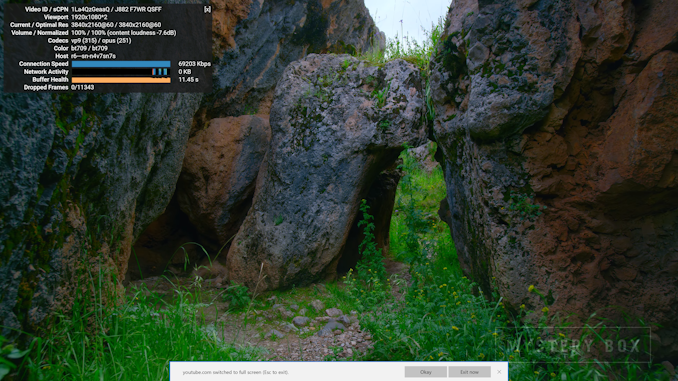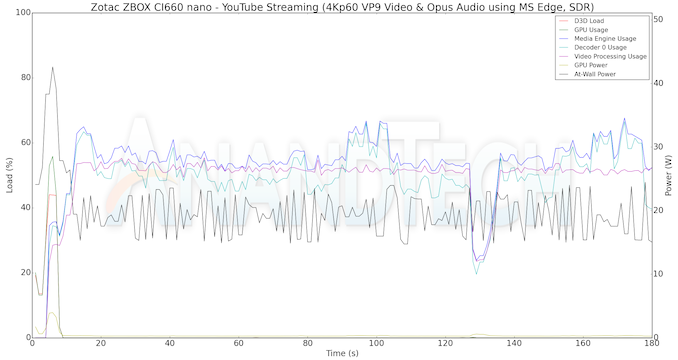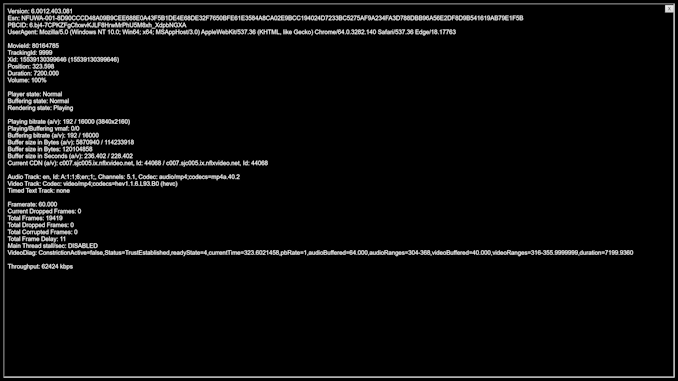The Zotac ZBOX CI660 nano Fanless mini-PC Review: A Promising HTPC Platform
by Ganesh T S on April 16, 2019 8:15 AM ESTHTPC Credentials - YouTube and Netflix Streaming
Our HTPC testing with respect to YouTube had been restricted to playback of a 1080p music video using the native HTML5 player in Firefox. The move to 4K, and the need to evaluate HDR support have made us choose Mystery Box's Peru 8K HDR 60FPS video as our test sample moving forward. On PCs running Windows, it is recommended that HDR streaming videos be viewed using the Microsoft Edge browser after putting the desktop in HDR mode. We evaluated the CI660 nano in SDR mode.
Since the streaming was done in SDR mode, the VP9 video stream with Opus audio was played back.
Various metrics of interest such as GPU usage and at-wall power consumption were recorded for the first four minutes of the playback of the above video. The numbers are graphed below.
The average power consumption for YouTube playback is slightly south of 20W. We see the GPU / D3D Load around the 40% mark in the initial stages when the lower resolution stream is decoded and upscaled for display at 4K resolution. The at-wall power consumption is correspondingly higher around 35W. However, once the 4K resolution stream starts getting decided, the media engine / decoder usage settles down around 50% and the D3D loading is no longer a significant factor.
The Netflix 4K HDR capability works with native Windows Store app as well as the Microsoft Edge browser. We used the Windows Store app to evaluate the playback of Season 4 Episode 4 of the Netflix Test Patterns title. The OS screenshot facilities obviously can't capture the video being played back. However, the debug OSD (reachable by Ctrl-Alt-Shift-D) can be recorded.
The (hevc) entry corresponding to the Video Track in the debug OSD, along with the A/V bitrate details (192 kbps / 16 Mbps) indicate that the 4K stream is indeed being played back. Similar to the YouTube streaming case, metrics such as GPU usage and at-wall power consumption were recorded for the first three minutes of the playback of the title. The numbers are graphed below.
In the steady state (4K decode and playback), the power consumption is around 18W, and the media engine / decoder load is around 65%.














23 Comments
View All Comments
eastcoast_pete - Tuesday, April 16, 2019 - link
Thanks Ganesh! Two comments, one question - question first:Was your choice of a SATA SSD based on the ability of the ZBOX to support (not support) an NVMe SSD, or based on what parts were available?
As a comment, use of slower vs. faster storage (SATA vs NVMe) will obviously affect a number of performance benchmarks. Why not standardize on one unless the unit tested won't support the better option?
My other comment is about the pricing of the ZBOX (bare bone): not a good value proposition for HTPC use, given that the current i7 NUC is cheaper, with a superior CPU/GPU. The presence of two gigabit ethernet connections in the ZBOX might be a plus in certain situations, but otherwise it's overpriced compared to the NUC.
ganeshts - Wednesday, April 17, 2019 - link
No NVMe SSD support in the CI660 nano. I had to use a SATA drive, and chose the best one available at my disposal from a cost viewpoint (at the time I configured the review sample - sometime in early Q4 2018).You are right about standardizing the storage drive. However, we tend to choose a drive available in retail for a reasonable cost at the time of configuring the review sample. Since we review a system or two each quarter, it becomes difficult to use the same drive across a large number of reviews. That said, you can find that we either use Crucial SATA SSDs (MX200 / BX300) or Samsung / WD NVMe SSDs (950 PRO / WD Black / SanDisk Extreme Pro) unless the sample comes pre-configured with different SSDs by the vendor (eg. - Hades Canyon).
The CI6xx nano platform is suitable for HTPCs, though, the i7 model might be a bit too pricey for that sole purpose. As one of the other commentators noted, Zotac does have i3- and i5- models in the series.
mooninite - Tuesday, April 16, 2019 - link
$865 is $300 too much. Looks like most of this cost is tied up with the use of an i7, which is completely unnecessary in this form factor. CPU power is not the limitation here. The GPU is.I can't see this as a big seller over a NUC.
mooninite - Tuesday, April 16, 2019 - link
Also, I wish Zotac had come out with their AMD mini-pcs with Vega graphics. Such a shame... that would have sold. I wonder why they backed out.Haawser - Wednesday, April 17, 2019 - link
Agreed, I'd rather have a 15W Ryzen 7 3700U in this form factor. Because UHD620 is going to be a severe limitation for anything beyond the most basic low res, minimum settings gaming. Whereas at 720p/med fullscreen, Vega 10 should play pretty much anything.No idea why Zotac don't offer a Ryzen APU version. Intel 'discounts' maybe ? Or rather, threats of removing them if Zotac don't play ball ? Wouldn't put it past them to offer 'inducemets' like that. Their history being what it is.
lukethedrifter - Tuesday, April 16, 2019 - link
There are i3 and i5 versions as well, ci620 and ci640 respectively.This is a niche product for those who want something NUC-sized but fanless, for which there are relatively few options.That's the selling point, not that it's price competitive with regular NUCs.
Beaver M. - Monday, April 29, 2019 - link
Or an Nvidia Shield, which is still the best and cheapest way to get what an HTPC is supposed to do.mikato - Tuesday, April 16, 2019 - link
Noise question here... Ganesh, you said you were disappointed in the fan noise of the Intel NUC8i7BEH though I didn't see much detail. How bad was it (idle and when streaming something), and is this ZBOX far better noise-wise because it's fanless?ganeshts - Wednesday, April 17, 2019 - link
The Bean Canyon NUC's fan is problematic because it is small and high-pitched when there is sudden load on the CPU. At idle, not that much. But, network streaming and even Kodi playback sometimes makes the unit hot enough for the fan to turn on. It is audible from 10 ft away, particularly during quiet scenes in the movie. The ZBOX noise is inaudible at that range - so, for the HTPC user who isn't very picky, it might work.That said, there are some passive chasses for the Bean Canyon NUCs in the market. Those might be worth a look. However, that is not a 'ready-out-of-the-box' solution.
mikato - Friday, May 3, 2019 - link
Thanks! Please keep include noise as a concern in these mini PCs.